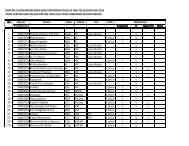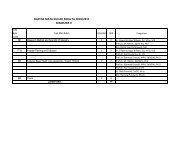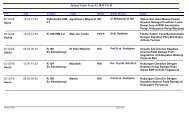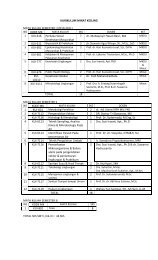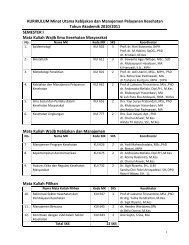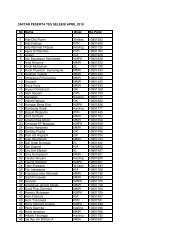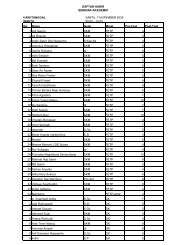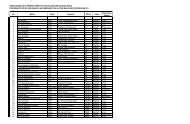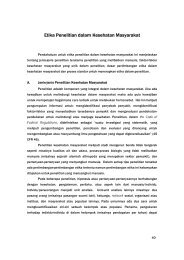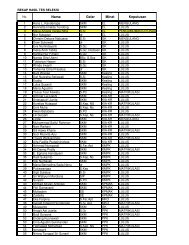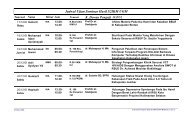analisis abc terhadap perencanaan kebutuhan obat di rsud kota ...
analisis abc terhadap perencanaan kebutuhan obat di rsud kota ...
analisis abc terhadap perencanaan kebutuhan obat di rsud kota ...
Create successful ePaper yourself
Turn your PDF publications into a flip-book with our unique Google optimized e-Paper software.
ANALISIS ABC<br />
TERHADAP PERENCANAAN KEBUTUHAN OBAT<br />
DI RSUD KOTA YOGYAKARTA TAHUN 2010<br />
Summary<br />
Untuk Memenuhi sebagian persyaratan<br />
Mencapai derajat Sarjana S-2<br />
Minat Utama Manajemen dan Kebijakan Obat<br />
Program Stu<strong>di</strong> Ilmu Kesehatan Masyarakat<br />
Diajukan oleh :<br />
HENY PUSPASARI<br />
09/293464/PKU/10975<br />
Kepada<br />
PROGRAM PASCASARJANA<br />
FAKULTAS KEDOKTERAN<br />
UNIVERSITAS GADJAH MADA<br />
YOGYAKARTA<br />
2011
SUMMARY<br />
INTRODUCTION<br />
General Hospital of Kota Yogyakarta has been established to be BLUD<br />
(Badan Layanan Umum Daerah Penuh – Local Public Service Agency) on<br />
12 September 2007 with Mayor’s Decision Number 423/KEP/2007 year<br />
2007. It is expected that with BLUD status, the General Hospital of Kota<br />
Yogyakarta will become more flexible, efficient and effective in provi<strong>di</strong>ng<br />
the health service for people. General Hospital of Kota Yogyakarta<br />
established to be Hospital Class B Non Education on 28 November 2007<br />
with Ministry of Health’s Decision of Indonesia Republic Number<br />
1214/MENKES/SK/XI/2007. By establishing the General Hospital of Kota<br />
Yogyakarta as Hospital Class B Non Education and then the<br />
organizational structure and job description are enhanced by the<br />
regulation made by The Mayor of Yogyakarta Number 9 Year 2008 about<br />
The Establishment, Structure, Position and The Main Obligation of Local<br />
Technical Agency which already suited to the Government Regulation<br />
Number 41 Year 2007. The name of RSUD Wirosaban Yogyakarta is<br />
changed into Jogja Hospital. The change of the name already established<br />
by the Mayor through Mayor’s Decision (Kepwal) Yogyakarta Number<br />
337/KEP/2010 (Anonymous, 2010).<br />
So far RSUD Kota Yogyakarta is using consumption method for the<br />
drug planning in order to supply the drug in hospital, to fulfill all the drug<br />
demands, the plan is carried out by each unit in the hospital, and then the<br />
plan is recapitulated by pharmacist of pharmacy storeroom which is next<br />
corrected by the head of the IFRS. However, so far in RSUD Kota<br />
Yogyakarta the evaluation has not been carried out yet toward the plan<br />
and the need of the drug, and there are some lack of drug in the hospital<br />
so the number of prescriptions that has not been served around 3.29%,<br />
The plan that has been made is supposed to be evaluated by using<br />
ABC value analysis method as the correction of the economist aspect,<br />
because one type of drug can take big budget caused by the use of lot or
the expensive price. By using ABC value analysis can be identified the<br />
types of the drug started from the group of the drug which needs the<br />
biggest part of the budget or measure the type of the drugs that have to be<br />
prioritized by seeing the budget used to purchase those drugs (Quick et al<br />
1997).<br />
ABC analysis is also well known as Pareto analysis or Pareto Law<br />
80/20 is one of the methods used in logistic management to classify the<br />
group of goods into three, which is group A, B and C. A is goods with the<br />
amount of item about 10-20%, but has investment value around 75-80%<br />
from the total investment value, group b is goods with the amount of item<br />
around 10-20% but has investment value around 15-20% from the total<br />
investment value, however group C is goods with amount of the item<br />
around 60-80%, but has investment value around 5-10% from the total<br />
investment value. By classifying and then the way to manage each group<br />
can be easier, so the planning, the physical control, supplier ability and the<br />
decreasing the big stock safety can be better (Halloway&Green, 2003).<br />
To realize the efficiency and effectiveness of the budget that<br />
becomes the purpose of the implementation of BLUD system in health<br />
service of RSUD Kota Yogyakarta, whereas so far there is no evaluation<br />
yet toward the planning of the drug needs, whether using ABC method,<br />
VEN or revision method of drug list. By considering this thing, so the<br />
researches will conduct the evaluation toward drug planning in RSUD Kota<br />
Yogyakarta by seeing the pattern aspect in<strong>di</strong>cator of top 10 <strong>di</strong>seases,<br />
SPM RS, the amount of patients visitations and drug budget, from ABC<br />
analysis which is one of the instruments to evaluate the planning of the<br />
drug need that is going to be conducted, whereas the benefits of ABC<br />
analysis, such as it can measure whether the plan that is carried out so far<br />
Is effective, efficient, and fits to the need or not, seen from the<br />
appropriateness in<strong>di</strong>cator with the top <strong>di</strong>sease pattern, and it can find out<br />
the drug priority to fulfill the need of drug in RSUD Kota Yogyakarta.
METHOD OF THE STUDY<br />
This research is an analytic descriptive research with case study<br />
framework which has purpose to obtain the description about the drug<br />
planning process in Pharmacy Installation of RSUD Kota Yogyakarta. The<br />
data obtained through collecting and observing the secondary data year<br />
2010, such as: the data of top 10 <strong>di</strong>seases, Work Unit Budget Document<br />
(Dokumen Anggaran Satuan Kerja – DASK), drug expenses, income<br />
document of hospital and drug, the list of drug planning year 2010. The<br />
primary data obtained from the observation result and in-depth interview<br />
with the Director of RSUD Kota Yogyakarta, the head of IFRS, the Vice<br />
Director of Public Affair and Finance, the Section Chief of Service Support,<br />
the Responsible Pharmacist of the Pharmacy’s Supplies, and the PFT<br />
Secretary.<br />
The result of the study is in the form of recommendation of drug<br />
items in the drug planning in RSUD Kota Yogyakarta by using ABC<br />
analysis which can be used as the base of arrangement of the drug need<br />
planning in RSUD Kota Yogyakarta, whereas the Group A has investment<br />
value 80% from the total budget of drug planning is supposed to be<br />
planned optimally so the plan is obtained effectively and efficiently based<br />
on the <strong>di</strong>sease pattern mostly found in the hospital.<br />
THE RESULT OF THE STUDY AND DISCUSSION<br />
1. The Description of Top 10 Disease Patterns<br />
The <strong>di</strong>sease patter found in RSUD Kota Yogyakarta year 2010<br />
as follow:<br />
a. Outpatient <strong>di</strong>sease pattern<br />
Below is the description of the top 10 outpatient <strong>di</strong>seases in<br />
RSUD Kota Yogyakarta year 2010
Table 1. Top 10 Outpatient Disease from General Patient/Reguler<br />
and Midwifery Service in RSUD Kota Yogyakarta Year 2010<br />
No. Disease Pattern Number of<br />
Patients<br />
1 Fever, unspecified 1190<br />
2 Acne vulgaris 1156<br />
3 Supervision of normal pregnancy, unspecified 849<br />
4 Cerumen Impact 810<br />
5 General Examination and Investigation without 739<br />
Complaint<br />
6 Injuries 573<br />
7 Necrosis of pulp 568<br />
8 Cough 530<br />
9 Konvalesen (pemulihan) 505<br />
10 The others extreme otitis infection 453<br />
Data Source: Me<strong>di</strong>cal Record Section of RSUD Kota Yogyakarta<br />
Table 2. Top 10 Askes Outpatient Disease and Midwifery Service in<br />
RSUD Kota Yogyakarta Year 2010<br />
No. Disease Pattern Number of<br />
Patients<br />
1 DM Non-dependent Insulin without complication 8954<br />
2 Essential hypertension (primary) 3130<br />
3 Presbyopia 1611<br />
4 Others artrosis 1495<br />
5 DM YTI without complication 1405<br />
6 Stroke Infark 1385<br />
7 Chronic ischaemic heart <strong>di</strong>sease, unspecified 1169<br />
8 DM non-dependent insulin 973<br />
9 Low back pain 911<br />
10 Myopia 726<br />
Data Source: Me<strong>di</strong>cal record session of RSUD Kota Yogyakarta<br />
Table 3. Top 10 Disease of Outpatient Maskin Patients and<br />
Midwifery Service in RSUD Kota Yogyakarta Year of 2010<br />
No. Disease Pattern Numbers of<br />
Patients<br />
1 DM non-dependent insulin without complication 1423<br />
2 Stroke Infark 993<br />
3 Congestive heart failure 697<br />
4 Chronic ischaemic heart <strong>di</strong>sease, unspecified 594<br />
5 Supervision of normal pregnancy, unspecified 589<br />
6 Epilepsi 585<br />
7 Essential hypertension (primary) 506<br />
8 Low back pain 494<br />
9 Decompensation Cor<strong>di</strong>s (Heart <strong>di</strong>sease) 478<br />
10 Others artrosis 451<br />
Data Source: Me<strong>di</strong>cal Record Section RSUD Kota Yogyakarta
From the tables above, it can be seen that the <strong>di</strong>sease<br />
pattern of outpatient patient year of 2010 from askes patient and<br />
maskin is DM non dependent insulin without complication. The<br />
<strong>di</strong>sease mostly found regular patient is fever unspecified. The<br />
pattern of <strong>di</strong>seases mostly found is hypertension, stroke, artrosis,<br />
supervision of normal pregnancy, CHD, DM YTI without<br />
complication, presbyopia, and serumen impact.<br />
b. Disease pattern of hospitalization patients<br />
Below is the description of <strong>di</strong>sease pattern of hospitalization<br />
patients in RSUD Kota Yogyakarta year of 2010<br />
Table 4. Top 10 Disease of Regular Hospitalization Patients and<br />
Midwifery Service in RSUD Kota Yogyakarta year of 2010<br />
No. Disease Pattern Number of<br />
Patient<br />
1 Dengue hemorrhagic fever (DHF) 363<br />
2 Dengue fever (classic dengue) 272<br />
3 Acute Gastroenteritis (<strong>di</strong>arrhea, colitis, enteritis) 242<br />
4 Single spontaneous delivery, unspecifed 177<br />
5 Acute upper respiratoty infection, unspecifed 155<br />
6 Exceptional large baby 151<br />
7 Fever, unspecifed 127<br />
8 Delivery by caesarae section, unspecifed 68<br />
9 Normal birth 66<br />
10 Bacterial infection, unspecifed 62<br />
Data Source: Me<strong>di</strong>cal Record Section of RSUD Kota Yogyakarta<br />
Table 5. Top 10 Disease of Askes Hospitalization Patients and<br />
Midwifery Service in RSUD Kota Yogyakarta year of 2010<br />
No. Disease Pattern Number of<br />
Patient<br />
1 Dengue hemorrhagic fever (DHF) 68<br />
2 DM non-dependent insulin without complication 63<br />
3 Dengue fever (classic dengue) 57<br />
4 Acute Gastroenteritis (<strong>di</strong>arrhea, colitis, enteritis) 53<br />
5 Essential hypertension (primary) 53<br />
6 Acute myocar<strong>di</strong>al infarction, unspecified 47<br />
7 Fever, unspecifed 46<br />
8 Single spontaneous delivery, unspecifed 46<br />
9 Exceptional large baby 40<br />
10 Disorder of urinary system, unspecifed 33<br />
Data Source: Me<strong>di</strong>cal Record Section RSUD Kota Yogyakarta
Table 6. Top 10 Disease of Maskin Hospitalization Patients and<br />
Midwifery Service in RSUD Kota Yogyakarta year of 2010<br />
No.<br />
Pola Penyakit<br />
Disease Pattern<br />
Jumlah<br />
Pasien<br />
Number of<br />
Patient<br />
1 Exceptional large baby 264<br />
2 Single spontaneous delivery, unspecifed 240<br />
3 Dengue hemorrhagic fever (DHF) 168<br />
4 Delivery by caesarae section, unspecifed 140<br />
5 Normal birth 104<br />
6 Dengue fever (classic dengue) 94<br />
7 Acute Gastroenteritis (<strong>di</strong>arrhea, colitis, enteritis) 81<br />
8 Stroke Infark 63<br />
9 Essential hypertension (primary) 42<br />
10 Fever, unspecifed 35<br />
Data Source: Me<strong>di</strong>cal Record Section of RSUD Kota Yogyakarta<br />
From the tables above, it can be seen that the <strong>di</strong>sease<br />
pattern of hospitalization patients in the year of 2010 the <strong>di</strong>sease<br />
mostly found in askes patient, regular and maskin is dengue fever<br />
(DHF). The pattern that is mostly found other than that is <strong>di</strong>abetes<br />
mellitus, hypertension, stroke, unspecified spontaneous birth,<br />
childbirth, gastroenteritis, unspecified fever, caesarea section and<br />
bacterial infection unspecified.<br />
2. Human Resources<br />
The availability of Human Resource (SDM) in planning the<br />
drug need is very important in an organization. To support the<br />
fluency of the organization, it is needed sufficient employee from<br />
the aspect of number, competency as well as the equality.<br />
Human Resources available in IFRS RSUD Kota Yogyakarta<br />
is consisting from the HEAD of IFRT is a pharmacist with master<br />
degree and the employees are 7 pharmacists and 17 pharmacist’<br />
assistants and 4 administration workers. The Human Resource<br />
criteria in Jogja Hospital has fulfilled the criteria established by<br />
Depkes RI (2002), which is consisting of pharmacist, pharmacist’<br />
assistant, <strong>di</strong>ploma worker and SMU/SMF graduate.
3. Budget<br />
Budget is one of the important aspect in the continuity of an<br />
organization, as well as the IFRS that needs budget support to<br />
carry out the activities. From the result of the study shows that<br />
budget for the need of RSUD Kota Yogyakarta has fulfilled the need<br />
of drug expense, obtained from the interview with the Director of<br />
RSUD Kota Yogyakarta and the Vice Director of Public Affair and<br />
Finance, it is found out that the budget for drug so far never had a<br />
shortage and the budget for pharmacy supplies infrastructure need<br />
reaches more than 40% from the total of hospital budget, though<br />
the IFRS asks ad<strong>di</strong>tional budget to purchase drug then it will be<br />
fulfilled with requirements the income obtained from drug stays high<br />
if compared to the expenses spent for the drug. The ad<strong>di</strong>tional<br />
budget if available and if more than the budget that has been<br />
planned in this year then it will be put to the expense budget of the<br />
next year.<br />
This thing shows that the understan<strong>di</strong>ng of the decision<br />
makers toward budget for the need of pharmacy supplies<br />
infrastructure is better for the year 2007-2010. Based on WHO<br />
(1988) the drug expense is one of the biggest part from the health<br />
budget, in some developed countries is around 10-15% from the<br />
health budget. However, in developing countries the budget is<br />
around 35-66%. Based on Quick et al (1997) in developing<br />
countries the drug expense is the second largest budget after<br />
salary, which is 40% from the whole hospital budget.<br />
4. Me<strong>di</strong>cal Service Standard<br />
Me<strong>di</strong>cal Service Standard of RSUD Kota Yogyakarta made<br />
by each of SMF in the hospital cooperating with me<strong>di</strong>cal committee<br />
and PFT in the year 2006 and has been established the revision in<br />
2010. The me<strong>di</strong>cation standard is consisting of 11 books about
internal <strong>di</strong>sease, pe<strong>di</strong>atric, obstetric, neurology, psychopathic, ENT,<br />
eyes, skin and venereal, teeth and mouth, and emergency.<br />
Accor<strong>di</strong>ng to Ningtyas (1998) shows that after the<br />
implementation of me<strong>di</strong>cal service standard, the total budget of the<br />
treatment service in elective section Caesarea action in RSUD<br />
Budhi Asih is found out that the average increases as big as 63.822<br />
Rupiahs, however the budget variation in a whole is decreasing<br />
significantly.<br />
5. Management Information System<br />
IFRS RSUD Kota Yogyakarta has been using the<br />
computerization system as the management information system,<br />
whereas the drug data management from ordering, goods<br />
spen<strong>di</strong>ng, recapitulating of the drug usage and so on has been<br />
computerized, though there is no specific software used to manage<br />
the data. Accor<strong>di</strong>ng to Quick et al (1997) specific computerization<br />
program for drug management often used to measure the need of<br />
drug, supply, inventory management or the drug usage analysis.<br />
Drug information is increasing with electronic communication<br />
system.<br />
6. Formulary<br />
The formulary of RSUD Kota Yogyakarta made by PFT in<br />
2004 and in 2008 there is a revision and until now still in the second<br />
revision process, this is appropriate with the result of the interview<br />
with the PFT Secretary, that formulary is still in revision.<br />
The prescription percentage outside the formulary in<br />
outpatient installation during April-December 2010 reaches average<br />
value 8.28%, this thing shows that the appropriateness in<br />
prescribing with the formulary is still weak, whether in influencing<br />
the drug planning in hospital, because formulary is supposed to be<br />
used as reference in drug planning.
The hospital’s formulary is the list of drug that compromised<br />
along with the information that is supposed to be established in<br />
hospital arranged by the Pharmacy and Therapy Team and Hospital<br />
based on DOEN. Hospital’s formulary has function to provide<br />
information about drugs used by hospital. So it is obvious that<br />
formulary is used as reference in planning the usage of drugs in<br />
hospital (Dep.Kes, 2006).<br />
7. Pharmacy and Therapy Team (Panitia Farmasy dan Terapi –<br />
PFT)<br />
From the result of the study can be seen that PFT has been<br />
implementing the duties and functions as it supposed to be,<br />
however in arranging the drug planning still carried out only by IFRS<br />
through Responsible Pharmacist of Pharmacy’s Supplies and there<br />
is no special team yet in the planning process and the cooperation<br />
from the member of PFT is only in the selection process which is<br />
later put in the hospital formulary.<br />
In arranging the drug planning, PFT is supposed to be<br />
involved in the process because PFT is an organization that<br />
represents the communication connection between me<strong>di</strong>cal staff<br />
and pharmacy staff (Ningtyas, 1998). Before the drug planning is<br />
made, the drugs that will be supplied by hospital is supposed to be<br />
consulted first by management party, pharmacist, and physician<br />
through PFT (Suciati and A<strong>di</strong>sasmito, 2006).<br />
8. Drug Planning System Carried Out in IFRS RSUD Kota<br />
Yogyakarta Year 2010<br />
The planning is the activity process in choosing type, number<br />
and the price of the drug which is based on the need and budget.<br />
Accor<strong>di</strong>ng to the interview with the head of IFRS, that the method<br />
used so far in IFRS RSUD Kota Yogyakarta is consumption method<br />
and never been evaluated before about drug planning even with<br />
ABC method or by using other methods, though the hospital status
is BLUD. General Hospital of Kota Yogyakarta has been<br />
established to be BLUD (Badan Layanan Umum Daerah Penuh –<br />
Local Public Service Agency) in 12 September 2007 based on<br />
Mayor’s Decision Number 423/KEP/2007 year 2007. It is expected<br />
that with BLUD status, General Hospital of Kota Yogyakarta will<br />
become more flexible, efficient and effective in provi<strong>di</strong>ng health<br />
service to people (RSUD Kota Yogyakarta 2010).<br />
The planning is carried out by Responsible Pharmacist of<br />
Pharmacy’s Supplies by seeing the consumption data from the<br />
previous months measured per item of the drug and then<br />
associated to the <strong>di</strong>sease pattern as follow and the development of<br />
hospital as follow, it is also seen based on the budget and remnant<br />
stock. The planning carried for monthly consumption and the need<br />
per year. The head of IFRS is conducting final correction after the<br />
planning is made but the drug priority has not been considered yet.<br />
The consumption method is one of the planning methods that is<br />
very popular and mostly used. This planning is one of the early<br />
steps from the drug management that is supposed to be written.<br />
Because of the written plan and then it will be easier for the<br />
coor<strong>di</strong>nation between budget supplier and the usage of drug, so the<br />
budget for drug supplies can be optimized.<br />
9. ABC Analysis<br />
a. Maskin Unit<br />
The result of ABC analysis toward the drug need planning in<br />
maskin unit, such as: the number of the item, the percentage of the<br />
item, value and value percentage, as well as ten drugs with highest<br />
investment value per year in maskin unit can be seen in the table<br />
as follow:
Table 9. ABC Analysis from Maskin Unit in RSUD Kota Yogyakarta<br />
April-December 2010<br />
Item A B C Number of<br />
Number of the<br />
Item<br />
Quantity<br />
25 46 96 167<br />
Item Percentage 15% 27.5% 57.5% 100<br />
Value in Rp. 792.643.950 151.098.447 51.090.503 994.832.900<br />
% Value per year 80% 15% 5% 100%<br />
Data Source: Secondary data year 2010 that has been processed<br />
From the research, it can be seen that in maskin unit the<br />
group A uses the investment budget as big as 80% and group B<br />
uses the investment budget as big as 15% from the total investment<br />
budget. The amount of the drug item for each unit shows that group<br />
A reaches 10-20%, group B reaches more than 10-20% from the<br />
whole drug item that is available. This thing shows that the budget<br />
planning in unit maskin has shown the efficiency, whereas the<br />
biggest part of the budget is invested for drugs from group A, so<br />
those drugs required specific attention in planning it and in<br />
controlling the availability of the drugs from this group. Based on<br />
research conducted by Suciati and A<strong>di</strong>sasmito (2006) shows that<br />
the investment value group A and B uses the investment budget is<br />
as big as 90% from the whole investment, so it is required specific<br />
attention so the availability control always under control. The stock<br />
for both groups is supposed to be forced to be as low as possible,<br />
but the purchasing frequency is carried out often, just like what has<br />
been doing which is weekly. However, the good cooperation with<br />
the suppliers are supposed to be taken into account so the ordering<br />
process can be fulfilled on time, so there is no lack of drug.<br />
Jenis-jenis <strong>obat</strong> dari <strong>analisis</strong> ABC untuk unit maskin<br />
menunjukkan <strong>perencanaan</strong> sudah efektif. Sebagian besar
<strong>perencanaan</strong> <strong>obat</strong> unit maskin adalah untuk <strong>obat</strong>-<strong>obat</strong> golongan A<br />
yang <strong>di</strong>gunakan untuk salah satu terapi 10 penyakit terbanyak <strong>di</strong><br />
RSUD Kota Yogyakarta, yaitu <strong>di</strong>abetes melitus tergantung insulin<br />
atau tidak tergantung insulin seperti (novorapid, novomix,<br />
glurenorm dan glucobay 50).<br />
Types of drugs from ABC analysis for maskin unit shows that<br />
the planning is effective. Most of the drug planning in unit masking<br />
is fro group A which is used for one of the therapies for the top 10<br />
<strong>di</strong>sease in RSUD Kota Yogyakarta, such as <strong>di</strong>abetes mellitus which<br />
is depen<strong>di</strong>ng on the availability of insulin or not like (novorapid,<br />
novomix, glurenorm and glucobay 50).<br />
a. Unit Reguler<br />
Regular Unit<br />
Jumlah item, persen item, value dan persen value pertahun<br />
unit reguler dapat <strong>di</strong>lihat pada tabel berikut:<br />
The number of item, item percentage, value and value<br />
percentage per year in regular unit can be seen in the table as<br />
follow:<br />
Tabel 10. Analisis ABC dari Unit Reguler <strong>di</strong> RSUD Kota Yogyakarta<br />
Bulan April-Desember Tahun 2010<br />
Table 10. ABC Analysis from Regular Unit in RSUD Kota Yogyakarta<br />
April-December 2010<br />
Item A B C Jumlah<br />
Number of<br />
Quantity<br />
Jumlah Item 146 207 361 714<br />
Number of<br />
item<br />
Persen Item 20.5% 29% 50.6% 100<br />
Item<br />
Percentage<br />
Value 2.292.439.304 433.373.207 144.089.454 2.869.901.965<br />
dalam Rp<br />
Value in Rp<br />
% value 80% 15% 5% 100%<br />
pertahun<br />
Value per<br />
year<br />
Sumber Data: Data sekunder tahun 2010 yang telah <strong>di</strong> olah
Data Source: Secondary data year of 2010 that has been processed<br />
Dari hasil <strong>analisis</strong> ABC pada unit reguler <strong>di</strong>ketahui bahwa<br />
golongan A menyerap biaya investasi sebanyak 80% dan kelompok<br />
B menyerap biaya investasi sebanyak 15% dari total biaya investasi<br />
keseluruhan. Jumlah item <strong>obat</strong> menunjukkan bahwa golongan A<br />
mencapai 20%, golongan B mencapai lebih dari 10-20% item dan<br />
golongan C mencapai kurang dari 60-80% dari keseluruhan item<br />
<strong>obat</strong> yang ada. Hal ini menunjukkan bahwa dalam <strong>perencanaan</strong><br />
unit maskin anggaran <strong>obat</strong> telah menunjukkan efisien, <strong>di</strong>mana<br />
sebagian besar anggaran <strong>di</strong> investasikan untuk <strong>obat</strong>-<strong>obat</strong> golongan<br />
A.<br />
From the result of the ABC analysis in regular unit is found<br />
that that group A uses investment budget as big as 80% and group<br />
B uses the investment budget as big as 15% from the total<br />
investment budget. The number of drug item shows that group A<br />
reaches 20%, group B reaches more than 10-20% and group C<br />
reaches less than 60-80% from the whole drug item that is<br />
available. This thing shows that in the planning of regular unit<br />
shows that the drug budget is used efficiently, whereas most of the<br />
budget is invested to drugs from grup A.<br />
Types of drug from ABC analysis for maskin unit shows that<br />
the drug planning is effective, whereas the biggest past of the unit<br />
regular planning is for drugs from group A which is used for therapy<br />
for the top 10 <strong>di</strong>seases that mostly found in RSUD Kota<br />
Yogyakarta, such as bacterial infection or antibiotic drug type which<br />
is consisting of several types of drug like (anbacim inj, cefixim,<br />
levocin inf, mosardal inf, and sulbacef). The other drugs are drug<br />
from proton pump inhibitor, anti hypertension, anti platelet, anti<br />
vertigo, anti nausea, treatment for shock post trauma and so on.<br />
Maimun Research 92008) from the result of the classification<br />
antibiotic by using ABC analysis is found that there are 15 items of
antibiotic with the a lot usage amount, with average usage ≥ 200<br />
pert month, it means that there are 15 antibiotic that mostly used<br />
each month, that is categorized by the researcher as fast moving<br />
antibiotic.<br />
b. Askes Unit<br />
The number of the item, item percentage, value and value<br />
percentage per year in askes unit can be seen in the table below:<br />
Table 11. ABC Analysis from Askes Unit in RSUD Kota Yogyakarta<br />
April-December 2010<br />
Item A B C Number of<br />
Quantity<br />
Number of 63 90 211 364<br />
item<br />
item<br />
17.3% 24.7% 58% 100<br />
percentage<br />
Value in Rp 3.580.242.660 676.333.109 227.028.263 4.483.604.032<br />
% Value per 80% 15% 5% 100%<br />
year<br />
Data source: Secondary data year of 2010 that has been processed<br />
From the research is found that in askes unit the group A<br />
uses investment budget as big as 80% and group B uses the<br />
investment budget as big as 15% from the whole investment<br />
budget. The number of drug item for each unit shows that group A<br />
reaches 10-20%, group B reaches more than 10-20% and group c<br />
reaches less than 60-80% from the whole drug item that is<br />
available. This thing shows that in planning the askes unit is<br />
efficient, whereas most of the budget is invested to drugs from<br />
group A, so those drugs that required specific attention in planning<br />
and controlling the availability of the drug item from this group.<br />
Types of the drugs from ABC analysis for askes unit shows<br />
that the planning is effective most of the drug planning in askes unit<br />
is for drugs from group A that is used for one of the therapy of top<br />
10 <strong>di</strong>seases that mostly found in RSUD Kota Yogyakarta, such as
<strong>di</strong>abetes mellitus that is depen<strong>di</strong>ng on the usage of insulin or not,<br />
like (novorapid, novomix, glurenorm and glucobay 50). The other<br />
drugs are like valsartan for hypertension therapy, vaclo for stroke<br />
therapy and so on. This is just like the research conducted by<br />
Sukminingrum (2006) that shows from the whole drug tablet item<br />
that mostly prescribed, can be seen that the drugs that are mostly<br />
used shows the investment value from the whole drug planning<br />
budget is not really high, except for drugs for anti <strong>di</strong>abetes and anti<br />
hypertension.<br />
SUMMARY AND SUGGESTION<br />
A. Summary<br />
From the result of analysis ABC toward the drug need planning in<br />
Jogja Hospital year of 2010 can be summarized as follow:<br />
1. The drug need planning system in IFRS is using consumption<br />
method with planning process carried out by Responsible<br />
Pharmacist of Pharmacy’s Supplies and corrected by the head of<br />
IFR. In IFRS of RSUD Kota Yogyakarta, there is no special team<br />
yet to plan the drug need and there is no involvement from related<br />
parties.<br />
2. ABC analysis toward three service units that is consisting of:<br />
maskin unit, regular unit and askes unit in IFRS of RSUD Kota<br />
Yogyakarta is obtained that the investment value from the drug<br />
usageg value from each group whereas group A from each service<br />
unit shows Group A 80/20, Group B investment value 15% with the<br />
number of item >20% and Group C investment value 5% with the<br />
number of item
also efficient, it can be seen from the appropriateness of planning<br />
and the budget available which is prioritized for drugs investment<br />
from group A.<br />
B. Suggestion<br />
1. It is suggested to RSUD Kota Yogyakarta to apply or it is used<br />
to be the source of information in arranging the drug planning by<br />
making some policies as follow:<br />
a. Regulation<br />
1) The importance of ABC analysis toward drug planning in<br />
IFRS, so it can determine which drug that is supposed to<br />
be prioritized.<br />
2) The importance of forming drug planning team<br />
imme<strong>di</strong>ately which is consisting of some related parties<br />
and PFT of the hospital should take part so the<br />
availability of drugs can be controlled optimally and to<br />
minimize the drug percentage that is not served yet.<br />
3) The importance of improving the information<br />
management infrastructure as supportive infrastructure in<br />
planning the need of drug in IFRS.<br />
4) The need of further analysis or the combination of ABC<br />
analysis toward drug planning that is available and then<br />
combined with the other methods like VEN, so it is able to<br />
obtain the planning system that is more effective and<br />
efficient and it is also possible to measure whether drugs<br />
from group A are drugs that are vital, essential and non<br />
essential or not.<br />
b. Education:<br />
Training for drug planning team is needed to do the<br />
evaluation for everything that has been done so far so it is able to<br />
find out whether the planning system so far is appropriate with the<br />
need and effective.



